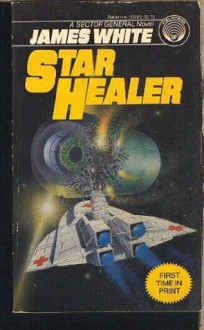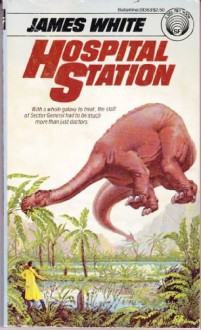
Warning: this review is pretty long.
Alien Emergencies is the second Sector General omnibus and includes either four or three works in the series, depending on how you count them. There's Ambulance Ship, Sector General, and Star Healer.
Ambulance Ship starts off with “Spacebird,” a story set on Sector General, a vast hospital in space. Ambulance Ship continues with stories detailing the first voyages of a specially designed ambulance ship, the first of its kind. True to the spirit of Sector General, the ambulance ship's crew includes not only humans like Senior Physician Conway and Pathologist Murchison, but also Dr. Prilicla, an incredibly fragile empathic alien who looks like a giant insect, and Charge Nurse Naydrad, who looks like a giant silver-furred caterpillar. These hospital employees are accompanied by members of the Monitor Corps, sort of an intergalactic police force. Ideally, everybody should work together in order to solve the medical mysteries they encounter in the best and quickest possible way, but things don't always go quite as smoothly as they should, especially at the beginning.
Sector General includes more stories dealing with the ambulance ship's various adventures. In Star Healer, however, Conway is provisionally promoted to the position of Diagnostician and can no longer be part of the ambulance ship's crew. Star Healer is the only novel-length work in the omnibus, and the only work where Conway is assigned several clinical cases and medical emergencies at once. His patients include: a violent alien that's about to give birth to its telepathic fetus and render it just as mindlessly violent as itself; Hudlars (very strong aliens) critically injured in a horrific accident; geriatric Hudlars whose bodies are deteriorating more rapidly than their minds; and a less time-sensitive case involving the Gogleskans, aliens who have an instinctual fear of physical contact, even with members of their own kind.
While Conway deals with all of this, he also has to adjust to one of the more difficult aspects of being a Diagnostician: learning to live with multiple alien personalities inside his head. Every Diagnostician permanently possesses at least four Educator tapes, the full medical knowledge of a doctor of another species. Unfortunately, Educator tapes don't just impart medical knowledge, they also include the tape provider's personality, dreams, nightmares, body sense, and more. It's disorienting, to say the least.
All right, now for my review. I bought Alien Emergencies because it was on sale and because I was intrigued by the idea of pacifist medical science fiction. However, I hadn't read the first omnibus and wasn't sure how lost I'd be. As it turned out, there was no need to worry. I adjusted to the world, the characters, and their relationships fairly quickly – the only thing that took me a while to figure out was that Conway and Murchison were either married or dating. It also helped that the stories were mostly set up as relatively self-contained medical mysteries. There were a lot of first contact situations, and the characters often had no more idea of what was going on than I did. Their primary focus was on figuring out the situations and what, if anything, they needed to do in order to help their patients.
I loved the whole “doctors in space” aspect. Even though the cynical part of me occasionally wondered how everything was being paid for and whether anyone at Sector General had ever heard of the word “budget,” I kind of loved how idealistic it all was. Sector General was this enormous place designed to accommodate any and all beings, either as patients or as medical staff. It was built to encourage cross-species cooperation and thereby promote peace, and the inspiration for its construction was a single horrific accident. The Monitor Corps could technically be considered a military force, but their presence in the book was entirely limited to assisting Sector General. There were no trigger-happy Monitor Corpsmen who abused their power, and not even a sense that such people could exist. It was weird, but nice.
Characterization was pretty basic, but I still had a few favorites. Prilicla was a big one. At first, I wondered how it could possibly be useful, considering that it had to keep well out of everyone's way in order to avoid being injured and considering that others' negative emotions could cause it a great deal of distress. However, I came to enjoy the effect that it had on those around it. Everyone made an extra effort to stay calm and reasonable in order to avoid upsetting or harming it, and its empathic abilities turned out to be incredibly useful in pretty much every situation.
Of all the works in this omnibus, my favorites were probably Star Healer and the first story in Sector General. I can't say much about the latter without giving too much away, but Star Healer was my favorite because it was the only work long enough to give readers a more complete picture of what life was like for medical staff at Sector General. I finally got to see Conway try to juggle multiple patients, talk to his patients about adjustments they'd have to make once they were discharged from the hospital, chat with friends during meal breaks, and demonstrate that he had at least a little bit of a personal life. It didn't go quite as far as I would have liked - Conway still felt like his social life mostly consisted of having sex with Murchison, and I was disappointed that one of Conway's cases was left with some significant loose ends - but it was good enough to make me wish the other works in the omnibus had been novels as well.
For the most part, I very much enjoyed Alien Emergencies. That said, it was by no means perfect, and certain aspects of it were very dated and just not okay (FYI, these books were published in the late '70s and early '80s).
One particular story got me to thinking about how disabilities were handled (or not handled) in the series. In that story, blind aliens
made telepathic contact with a group of aliens that couldn't move. The blind aliens could experience sight through the eyes of the aliens they'd contacted, and they wanted to be able to see so badly that they risked their lives to do it. It was the thing that inspired them to build a space ship and figure out space travel. Considering that these aliens had never been able to see, and had evolved so that they had abilities that allowed them to enjoy and interact with the world around them in other ways, I was uncomfortable with the idea that being able to see was so important to them. Why couldn't they have invented space travel because they'd made contact with those other aliens and were just plain curious about them?
(spoiler show)
Then there was the way women were written. Murchison was the only human female in the whole book, and one of maybe two or three female characters period. The number of times she was described as attractive was ludicrous. And she wasn't even attractive in a specific way – I couldn't tell you what color her eyes or hair were, or how tall she was, or if she had freckles. She was just generically gorgeous in such a way that all human males found her attractive, and White felt the need to repeatedly remind readers of this. To be fair, this wasn't the only thing White repeated. One of this series' other problems was that White copied and pasted certain descriptions and explanations from one story to the next, and sometimes multiple times in a single story.
The mentions of Murchison's attractiveness thankfully eventually decreased in frequency, but there were still moments that made me angry enough that I needed to take a break. The one that sticks in my mind the most was the way Murchison's request to use an Educator tape was handled. Here is what she was told:
“'Absolutely not, Pathologist Murchison! I am well aware that the Educator tapes would assist you in your work. But you and the other females or extraterrestrial female equivalents on the staff will have to continue using your brains, such as they are, unaided. It is regrettable, but you females have a deep, ineradicable and sex-based aversion, a form of hyperfastidiousness, which will not allow you to share your minds with an alien personality which is unaffected by your sexual...'” (375)
Either O'Mara was about to say that women (human or otherwise) couldn't use Educator tapes because they couldn't handle carrying around minds that wouldn't find them attractive, or he was about to say that one gender (female) couldn't comfortably accommodate the mind of another gender (male). Either interpretation is upsetting, the first because it presents women as beings that care more about whether they're considered attractive than men do, and the second because it indicates unexamined problems with the Educator tapes themselves. Did White mean to say that the Sector General universe didn't have a single talented and knowledgeable female doctor who could contribute an Educator tape? At the very least, there could have been OB/GYN-specific Educator tapes provided by female medical professionals whose species aren't always comfortable with males providing that kind of care.
Another area that I didn't think White had thought through very well was the Monitor Corps. Maybe this was addressed in the first omnibus, but I thought it was odd that, in a universe where humans weren't considered the superior beings, the intergalactic police force was composed almost entirely of humans. Why wasn't the Monitor Corps as diverse as Sector General?
So, yes, I had some issues with this series, but I still plan to read more of it. "Doctors in space" really works for me.
Extras:
The book includes two introductions, one by David Langford and one by the author. A word of warning: one of these (I can't remember which) majorly spoiled the very first story in the book and probably several in omnibus volumes I haven't yet read. They were very much written for people who were already fans of the series, so, while they did contain some helpful and/or interesting information, I'd recommend that newbies like myself skip them and read them later.
(Original review, with read-alikes, posted on A Library Girl's Familiar Diversions.)


 Log in with Facebook
Log in with Facebook 








